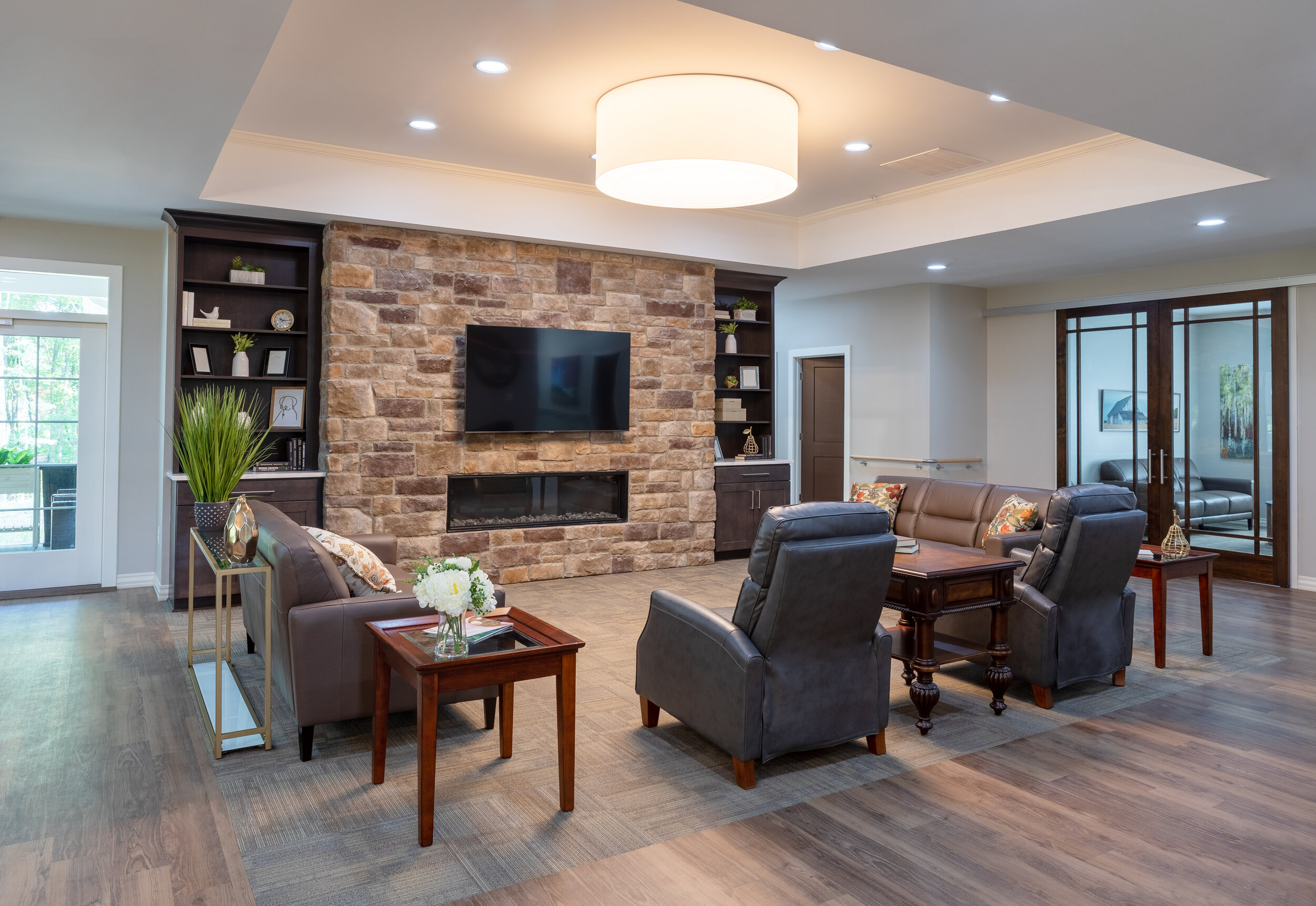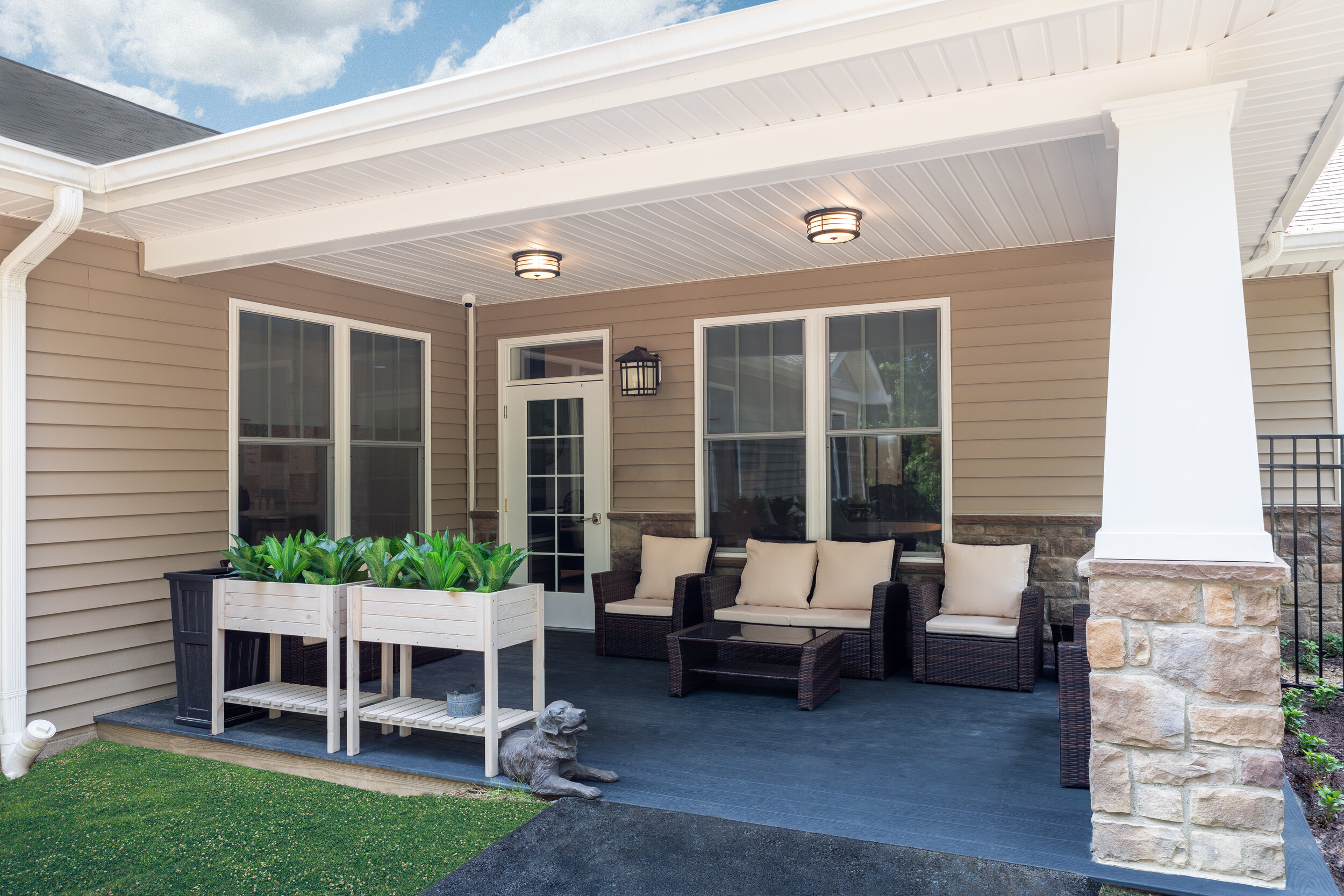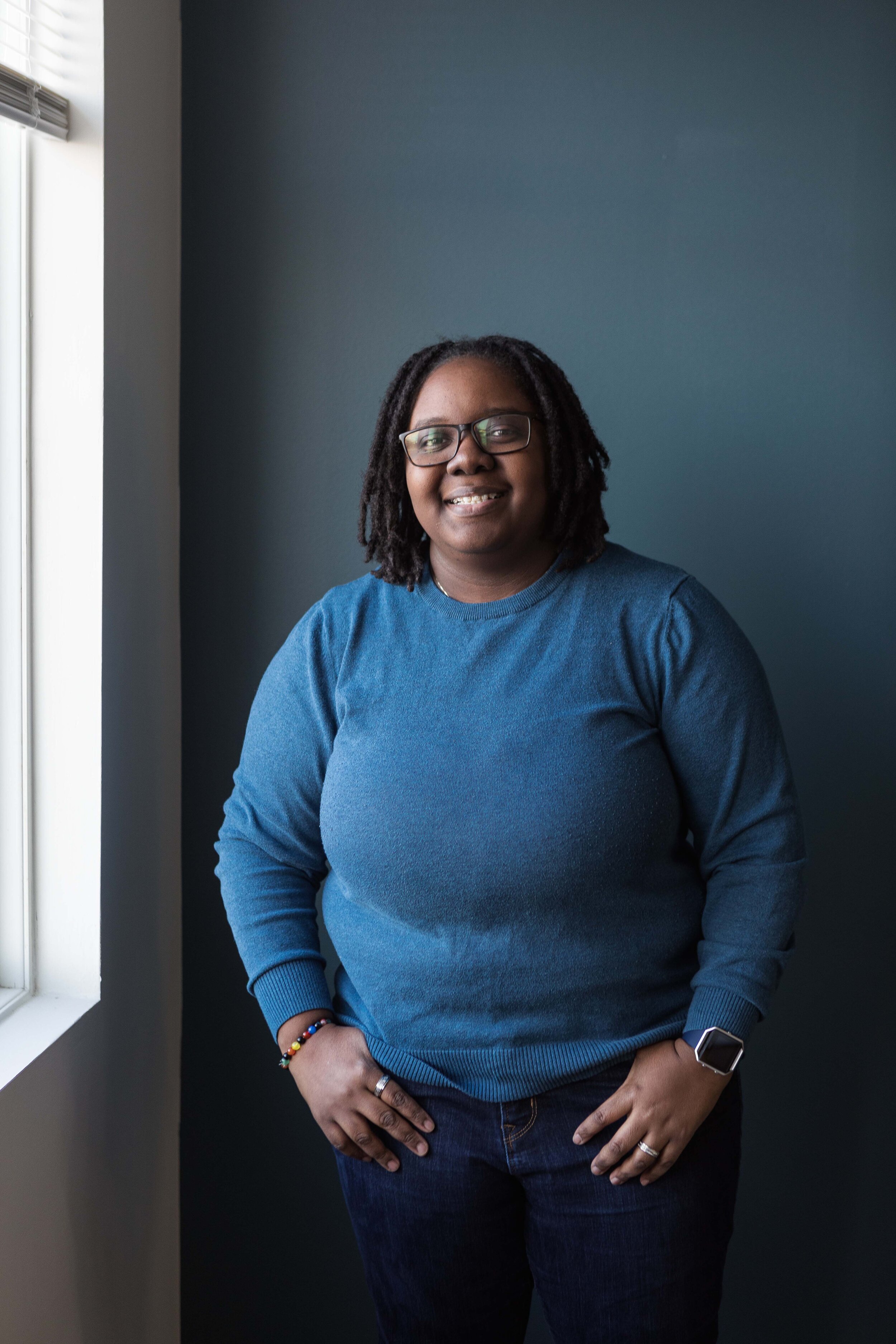By: Alexandra Cohl
Interview with Dave Risi: Evermore Senior Living, Residential Assisted Living, and Opening During a Pandemic
This week, I spoke with Dave Risi, the owner and operator of Evermore Senior Living, a residential assisted living space that opened in Lake Ridge, Virginia during 2020. Dave has been working with the JSR team to build this facility and create a space that fulfills the needs of its residents. He and I spoke about the inspiration behind Evermore, how the person-centered approach benefits both residents and staff members, and the challenges—and surprising benefits—of opening during a pandemic. This conversation was full of laughter and good humor, so be sure to insert some laughs in your head as you are reading through. You can learn more about Evermore here.
This interview has been edited for clarity and flow.
Dave, thank you for joining me today to talk about Evermore Senior Living. As the owner, can you tell me a little bit about what you do there?
Thank you for inviting me. It’s an honor to be here. So I am the owner and operator of Evermore Senior Living, and I have a background in health and safety. I’ve been doing health and safety for about 30 years and decided, “You know what? It’s the right thing to do at the right time.” So, I am not there for day-to-day operations, but I’m there to make sure that our staff has everything they need to be successful.
Front Entrance, Evermore Senior Living
In terms of how it all got started, what was the inspiration point behind that?
It’s actually a cool story. Going back probably four years ago, we were looking for a place for my father-in-law—he’s a soft, gentle, little Sicilian man who’s really not outgoing and kind of reserved—and we were looking around for a place because it just became too much for my mother-in-law and we were seeing her age from being the caregiver. It was just too much for her. So, he and I got in the car and drove around, and I took him to a couple of larger facilities. And he looked up at it, looked down to me, and looked back up at it, and he’s like, “I’ve lived in a house my whole life, you know, I don’t wanna live in a condo,” and I’m like, “That’s cool. I heard that there’s some of these smaller homes that are being renovated. Let’s go check those out.” So, on my own I went and looked at a few and to be blunt, I was appalled. Some of these homes you walked in and you would have sworn there were 50 cats living in the house. It was just disgusting. The food was bad, they just parked people in front of the TV, and left them alone. And after being appalled I’m like, you know what, I’ve done real estate for years, and I know I could do this better. That was kind of the inspiration behind the whole thing, and when we started working with Jane, it was just a God-send. She’s been fantastic to help direct us and make sure we do it right, you know?
I love hearing the background. So, is your father-in-law now living in one of those spaces and loving it?
He would. Unfortunately, he passed. The time it takes to architect, engineer, buy our land, and everything else, it just took too long. But, we kind of dedicated the place and the whole concept to Frank.
That’s beautiful, and I’m sorry to hear that. So, we’re definitely going to get into the work you’ve been doing with JSR, and this might actually come up in your answer to this next question, but I love that there is a 4 to 1 ratio of residents to staff members. It is very much person-centered care, and I’m wondering how have you been able to do that because I know in other assisted living spaces, that’s not always possible.
So with only eight residents, the goal is to have at least two caregivers around there. If one resident is in high need of help, you still have somebody watching the fort, so to speak. They are the caregivers in these smaller homes, and they’re doing more than just caregiving. They actually get involved and help serve the food. They do the laundry. They’re doing other activities that they may not be doing at the large facilities.
That was a little challenge when we started interviewing people. They were like, “Oh, I need to…” and I’m like, “Yeah, we’re all in it.” This is a family-type environment and everybody rolls up their sleeves, and everybody pitches in, and it is different for our CNAS and med techs because they are going to do more activities than they would normally do. But it’s really a home environment.
When they walk in, they’re not really reporting to work. They’re just coming into a different home. They’re only dealing with eight residents, so they know a lot more details about them, and they can get a sense if they’re even just not having a good day. The level of care is a lot higher.
Yeah, and I imagine the quality of life of the residents is much higher, too, because they can actually build really close relationships with the staff members.
Exactly, exactly.
Last month, I spoke to Shernise and she told me a bit about Residential Assisted Living (RAL), and how it works, and I have two questions. My first question is based on what you just said and what I learned from Shernise. The eight residents aren’t necessarily related—though they could be—but that’s not really the normal situation. So, since they aren’t, how do residents normally get grouped together? Is there a system for that or does it happen randomly, based on what’s available? I’m very curious.
Resident Bedroom, Evermore Senior Living
It’s really random. We do have a husband and wife that’s looking at us. So, we might have a husband and wife where we might need to put two in the room, which our rooms are big enough to handle that. Or, we can bust down a wall and stick a doorway between the two. Or, they may want to be separate. You don’t know.
But, one of the key things that Shernise and the team brought to my attention was that it’s good to have multiple seating areas. Kind of how I relate to it now is our first couple of residents were gentlemen, which is ironic, but all these guys started moving in, and they all love sports, so they are in front of the 70-inch big screen, and they’re watching sports and their loving life and with each other, having fun. Well, then we have ladies move in, and they want to watch Hallmark. So we said, “Well, it’s good they’ve got a second seating area.” We actually have a second seating area, and it has worked out well to keep them separated that way.
Resident Living Room, Evermore Senior Living
That’s so fun. Second question, and you touched on it a little bit just now, but as the client to JSR, what was that process like from start to finish? I know Evermore is still relatively new, so were there any challenges that you learned or faced that you hadn’t initially anticipated?
Yeah, I’ve got so many stories I could tell you. It was really like drinking from a firehose. It was amazing when I started getting involved in that, and they started talking about things like the right building code for the State of Virginia for Prince William County and I didn’t know. So, then they did a deep dive in and went through that analysis and meeting with the county to go through the building codes and get involved with things like the fire sprinkler systems.
The challenge with Residential Assisted Living is that there’s no black and white way to build these homes in most locations. So, every time that we met with somebody with the county or with the state, you’d have to explain what it was.
And they kind of shook their head and would go, “Well, I’m not sure exactly how to address that question.” So, we were literally coming up with standards of how we’re going to build out the house. It wasn’t like we were building a 200-person facility where you know exactly what to build. This is a very different process. Working with Jane’s team—if there were one extreme of level of professionalism and building out a quasi-commercial facility, on the opposite end, I had my builder and this gentleman has been building residential homes for almost 40 years. Good, old boy, you know, country boy. So, it was kind of the yin and the yang.
Between the two of them, what we built was perfect. Because there were some things that were starting to go down the road of a little bit too much commercial and then my builder was a little bit too much residential, and each time there were questions or issues or things that we needed to go through, and the three of us sat down and rolled our sleeves up and discussed it. We came up with great answers. But, I think it was a learning curve for all three of us to be honest with.
Yeah, that’s great. I love it. You also opened in the middle of a pandemic, which presents its own challenges. I wonder if you could speak a little bit to that and what you’ve learned through opening during this time.
Hmm, first advice I would say is don’t do it. It’s extremely challenging. So, the first thing that changes obviously is the big open house. In my head, I had a big barbecue truck come in, I had a live band, I was going to blow it out. I was going to have a really big party and get involved with the city and the county and really just have a lot of fun with it. Couldn’t do that.
So, our open house was spread out over two days and we had prewrapped food and drinks, and people serving it. It was a very different environment. When we did open up, we were having a lot of issues because a lot of the facilities were still in lockdown. So, people that wanted to do a tour couldn’t come in and do a tour because they couldn’t leave their facility. And then the other ones were maybe at home because a lot of these residents that were in the larger facilities, the children started taking them home and said, “Well, we’ll do home healthcare for a while until this whole COVID thing calms down,” because they were afraid of lockdowns and everything else.
Outdoor Porch, Evermore Senior Living
A house like ours, you got to see it. I mean, it’s a very different model. It’s truly a hybrid between a regular, residential one and a larger facility. So, we really try to get people in but just getting them to tour their home was what was really tough. I mean, there’s a lot of fear out there. People were concerned about putting their parents in a facility and not being able to see them because of lockdown, especially when residents are on the second, third, or fourth story. You know, those were all the fears that went into it. A very tough time to open up. I wouldn’t advise it to anybody. It’s definitely been a challenge.
On the flip side, what we did was we came out with a COVID guide that said how we are different. So, for instance, everything’s on one story. So, even if there was a lockdown, which we haven’t had—knock on wood—everything’s one story, where you got extra-large windows. So worst-case, you could still sit outside the window and talk to your loved one. The way that we designed the house, there’s a clean area where the food and materials come in, and there’s a dirty area where it leaves. Our whole clean versus dirty and the transition on that really reduces the risk of COVID.
We just generally have less staff, less people, less caregivers. So, that’s a lot lower risk. We don’t have a large common area. And it’s still a home. Our residents are still there in the house. They’re sitting near each other, not next to each other, but they’re not stuck in their own apartment. They’re out in the living room or watching TV together, and if they wanted to go get something to drink, they stand up and go over to the kitchen and get a drink or a cup of coffee or a little snack. It’s a home—that’s their kitchen. So, it really gives them more of a sense of being home and not in a lockdown. They’re not in an apartment where staff members are going to bring them their meal and they have to eat in their room.
The other interesting thing that we did was on the air filtration. I had the fans oversized, so we could use HEPA filters, which filters out 99.97% of bacteria, mold, and any kind of particulates that are in the air. When COVID came out, I did a lot of research and I found UVC filters that you can put in after the HEPA filters. So, anything that gets through there like a virus, because viruses are so small, they go right through those filters and will be annihilated. It’s the same technology that hospitals use to sterilize equipment—the ultraviolet—that’s what we use in our air ducts. Very unique and it kills odors.
Well, that’s great. Definitely challenging, as you mentioned, but also what has been positive about this past year is figuring out better systems. I also love that these folks are not as isolated—because as I’m sure we both know, that’s been a huge problem for memory care, in particular for people dealing with that and just general mental health for older folks. That’s awesome. I have one final question for you, and you might have multiple answers to this, but you can choose one or a couple to answer. I’d love to hear about one of the most rewarding stories or experiences to come out of this approach to senior living, whether it’s with the residents or staff, or both.
I have two. One is staff-related and one is resident-related. When interviewing for staff, it was almost an instantaneous selection where you found the right person. We knew we had the right people because you could tell they were into it with their heart. When they would look at our model, they would sit back and the light bulb would go off, and they would say, “Hold on a 4 to 1 ratio? So, I’m really going to get to know these residents really well? And I’m not having to run around trying to quote, unquote, put out fires, and I can actually sit down and get to know them on a personal level and provide the level of care that I’ve always wanted to do?” Absolutely.
And the same thing with our executive director. She’s been phenomenal. She came from a larger facility, and her biggest “aha moment” was when we were interviewing her and she said, “You know, this is going to provide the environment where I can give the level of care I’ve always wanted to give.” So, from a staffing perspective, that’s probably most satisfying—when they’re truly happy to be able to provide a higher level of care.
From the resident side, our first resident had his wife and kids say, “Okay, well, he doesn’t really eat breakfast and he sleeps until 10 or 11 o’clock. He takes three or four naps during the daytime and that’s how he’s been for the last 20 years.” And he was really skinny—too skinny. We have a chef in the house, so the food’s phenomenal and are basically custom meals. To me that was one of the biggest things. I want to have the best food out there and when Bob moved in, he said, “I don’t like fish,” and I said, “Fish is off there for you. What else do you like?” He goes, “I love chicken.” Great! He’s in there about a month, and he gains 10 pounds.
He’s getting up at 8:00 a.m. and having a full breakfast—I couldn’t even eat as much as he was eating. He’s eaten more than he’s ever eaten in a long time. He just kept asking for more. And his sleeping got better. He might pass out on the couch here and there when he’s watching sports or whatever, but he doesn’t take a long nap during the daytime anymore. A lot of that is because of our activity schedule and the things that we do are things that they want to do. My daughter will show up every week for their standing game of chess. He loves chess. He’ll be like, “Oh, your daughter kicked my butt today again.” We joke about that.
The other thing is that we also have what’s called circadian rhythm lighting. And so it’s for people with sundowners. It just helps them get on a normal sleeping arrangement. So, in the morning it’s a nice sunrise, it’s really calm in the daytime—a nice bright light—and then in the evening, it’s like a sunset. It really helps them wind down at the end of the day and get calm and relax.
So, our residents are all on a good sleep schedule. We haven’t had anyone with sundowners yet, but that’s really what the design of the product was—to help eliminate or greatly reduce sundowners. But the folks without sundowners are definitely going to benefit from it. Their sleeping schedules are normalized. That’s been the nicest thing I’ve seen over the last few months. It’s really nice to see them get on a normal sleep schedule.
Well, you’re really curating a space centered to their needs and their wants, which makes a huge difference.
Yeah, exactly. I mean, it’s been life-changing for myself, our whole family. Both my girls are involved in it and my wife is definitely involved in it, and it’s just been a great journey so far.

















